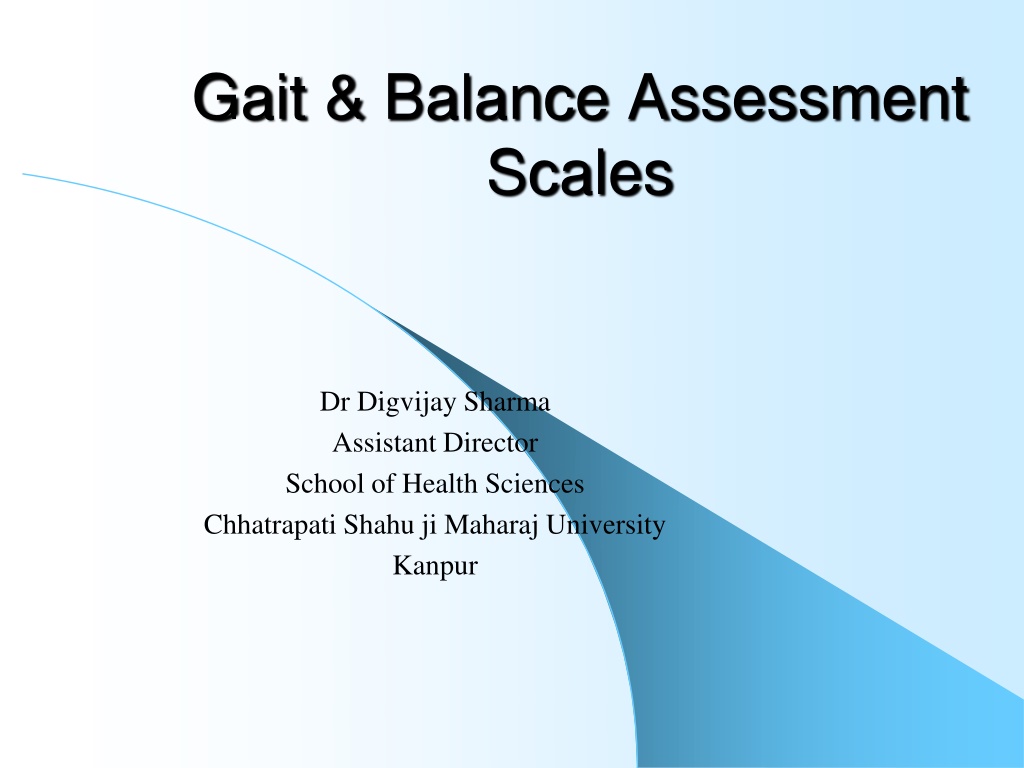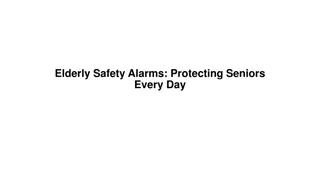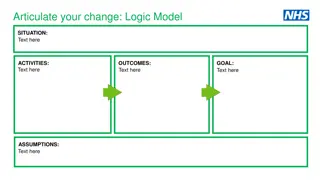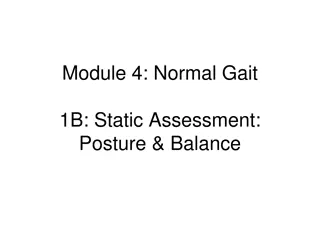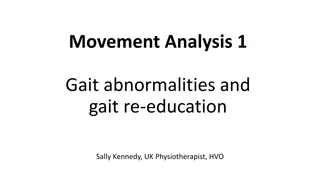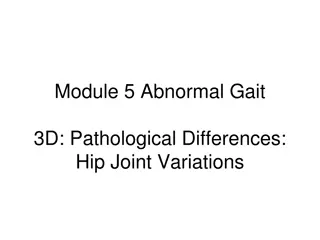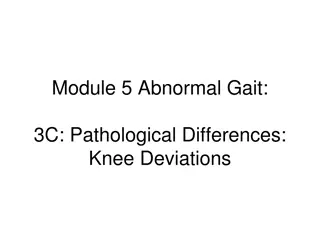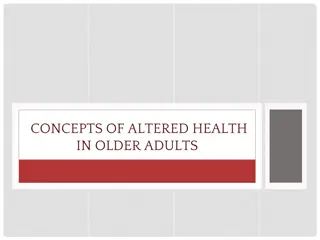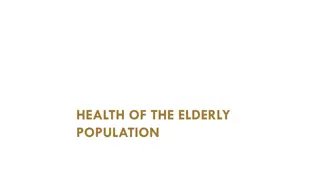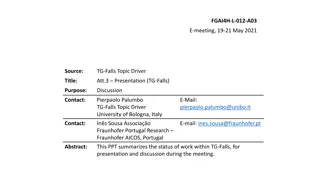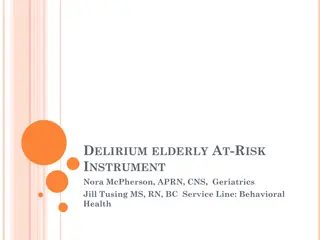Understanding Gait and Balance Assessment in Elderly
Balance in elderly individuals is essential to prevent falls and injuries. Disorders of balance can lead to difficulties in posture maintenance, walking, and dizziness. Neural components play a crucial role in postural control, involving sensory processes, central processing, and effector components. Falls are a significant concern among the elderly population, with a high risk of serious injuries leading to decreased quality of life and institutionalization.
Download Presentation

Please find below an Image/Link to download the presentation.
The content on the website is provided AS IS for your information and personal use only. It may not be sold, licensed, or shared on other websites without obtaining consent from the author. Download presentation by click this link. If you encounter any issues during the download, it is possible that the publisher has removed the file from their server.
E N D
Presentation Transcript
Gait & Balance Assessment Scales Dr Digvijay Sharma Assistant Director School of Health Sciences Chhatrapati Shahu ji Maharaj University Kanpur
Balance Balance is a multidimensional process and is the result of interactions between the individual, the task, and the environment. ANNE SHUMWAY-COOK Balance is the ability to maintain equilibrium: a state in which opposing physical forces cancel. In physiology, this is taken to mean the ability to control the center of mass with respect to gravity and the support surface.
Disorders of balance presents with difficulty in maintaining posture ,standing and walking and with a subjective sense of disequilibrium, a form of dizziness. The cerebellum and vestibular system organize antigravity responses needed to maintain the upright posture. Gait and balance problems are common in the elderly and contribute to the risk of falls and injury.
Neural components of postural control: Sensory processes visual, vestibular, somatosensory Central processing a higher-level integrative process Effector component sometimes referred to as the neuromuscular component postural alignment, ROM, muscle force, power & endurance
Definition of Falls World Health Organization definition of a fall: A fall is any event which results in a person coming to rest inadvertently on the ground or other lower level and other than as a consequence of a violent blow, loss of consciousness, or sudden onset of paralysis. (JAGS 1997)
Epidemiology -Thirty percent of patients over 65 fall each year -Risk of falling increases with age -Incidence of falling is greatest among patients in long term care facilities, nearly 50% per year Cummings and Nevitt, NEJM 872-3,94
Epidemiology -10-15% of falls result in serious injuries -at least 50% of these serious injuries are fractures -Falls may also break self confidence; many patients will limit their daily activities for fear of falling again -Injury, fear of falling, constriction of activities, and family concern can result in institutionalization Cummings and Nevitt, NEJM 872-3,94
In a prospective cohort study of 1103 patients, falls are a strong independent predictor of placement in a skilled nursing facility. Tinetti&Williams NEJM 1997; 337:1279-84
-Falls may be a sign of medical illness Pneumonia Stroke Anemia Dehydration
-People rely on many systems for postural stability Sensory Input: Visual Tactile Proprioceptive Vestibular Central processing Coordinated motor response -Impairments in any one of these systems decreases postural stability and increases the risk of falling Cummings and Nevitt, NEJM 872-3,94
Medical conditions that increase risk of falling: Arthritis Depressive symptoms Orthostasis Foot problems Stroke Impaired vision/cognition/balance/gait/strength/ROM Dementia 4 or more prescription medications Tinetti, NEJM 348;1, 2003
The risk of falling increases linearly with the number of risk factors from 8 percent with none to 78% with 4 or more risk factors (p<0.0001) Tinetti NEJM 1988;319:1701-7
Time periods of increased risk: -The month following hospital discharge -During acute illness -During exacerbations of chronic illness Tinetti, NEJM 348;1, 2003
Contributing environmental hazards: Curbs Stairs Cluttered floors Dim lighting Overly polished floors Throw rugs Thomas & Tinetti; Medical Care 38 (12), 2000
Assessment of Falls: History -Falls in the previous year -Medications -Limitations in physical function
Medications that increase fall risk: Psychotropics SSRIs TCAs Neuroleptics Benzodiazepines Anticonvulsants Leipzig & Tinetti; JAGS 47;30-9, 1999
Medications that increase fall risk: Psychotropics -Alertness and balance deteriorate with single doses of benzodiazepines and TCAs -Neuroleptics produce rigidity and extrapyramidal symptoms -Prescribing psychotropics in combination or at higher doses further increases the incidence of falls. Taking two or more drugs increases the risk more than one drug. -Patients taking psychotropics have impaired balance and reaction time Leipzig & Tinetti; JAGS 47;30-9, 1999
Medications that increases fall risk: Cardiac and Analgesic Class 1a Antiarrhythmics Digoxin Any Diuretic (thiazide>loop) Leipzig&Tinetti, JAGS 47;40-50 1999
The Reality Most of you will not practice in settings with a formal gait lab after completion of your residency You need practical gait assessment tools which can be used in the office or at the bedside
Gait and Balance Assessment Scales: 1.Berg Balance Scale 2. Tinetti gait and balance tool 3. Get Up and Go (GUG) 4.Timed Get Up and Go (TGUG) 5. Expanded Timed Get Up and Go (ETGUG) 6. One Leg Balance 7. Functional Reach (FR) 8. Four Square Step Test (FSST)
Berg Balance Scale It is a widely used clinical test of a person's static and dynamic balance abilities,[1]. For functional balance tests, the BBS is generally considered to be the gold standard.[2] 1.Blum, Lisa; Korner-Bitensky, Nicol (May 2008). "Usefulness of the Berg Balance Scale in Stroke Rehabilitation: A Systematic Review .Physical Therapy. 88 (5): 559 566. 2.Langley, F.A. & Mackintosh, S.F.H. (2007). Functional balance assessment of older community dwelling adults: A systematic review of the literature .The Internet Journal of Allied Health Sciences and Practice, 5(4).
Berg Balance Scale The BBS is a qualitative measure that assesses balance via performing functional activities such as reaching, bending, transferring, and standing that incorporates most components of postural control
Berg Balance Scale Sitting and transferring safely between chairs. Standing with feet apart, feet together. Standing in single-leg stance. Standing with feet in the tandem Romberg position with eyes open or closed. Reaching and stooping down to pick something off the floor.
Berg Balance Scale Each item is scored along a 5-point scale, ranging from 0 to 4, each grade with well- established criteria Zero indicates the lowest level of function and 4 the highest level of function. The total score ranges from 0 to 56. The BBS is reliable (both inter- and intratester) and has concurrent and construct validity.
TINETTI Performance - Oriented Assessment of Mobility Problems in Elderly Patients Tinetti suggests that the assessment of mobility problems in the elderly should not be limited to the usual history, physical exam, EMG, and CT scans. In addition, the artificial setting of gait analysis does not measure the effect of environment on mobility and falling. Tinetti JAGS 34; 119-126, 1986
TINETTI In a study of 333 elderly patients, abnormalities in the standard neuromuscular exam did not always correlate with the presence or absence of abnormalities in functional mobility. For example, only 57% of patients that had difficulty raising feet from the floor had decreased lower extremity strength on physical exam. Tinetti & Ginter, JAMA Feb 26, 1988
TINETTI Balance and Gait tests: -Require no equipment and little experience to master -Reliable yet sensitive to significant changes -Reflects the position changes and gait maneuvers used during normal daily activities -Basic mobility skills of the elderly are getting out of a chair/ on and off a toilet, and walking a few feet. (Podsiadlo,JAGS1991) Tinetti JAGS 34; 119-126, 1986
TINETTI Tinetti s performance oriented assessment of BALANCE: -Sitting balance----------------------------------------1 -Arising from a chair----------------------------------2 -Attempts to rise---------------------------------------2 -Immediate standing balance------------------------2 -Standing balance -------------------------------------2 -Balance with eyes closed----------------------------1 -Turning 360--------------------------------------------1,1 -Nudge on sternum------------------------------------2 -Sitting down-------------------------------------------2 16 Tinetti JAGS 34:119-126, 1986
TINETTI The balance portion of the exam allows for various position changes that stress stability. The observer must note any movements or gestures that suggest instability, such as grabbing for support, staggering, etc. Tinetti JAGS 34:119-126, 1986
TINETTI Tinetti performance oriented assessment of GAIT: -Initiation of gait------------------------------ 1 -Step height-------------------------------------2 -Step length-------------------------------------2 -Step symmetry-------------------------------- 1 -Step continuity-------------------------------- 1 -Path deviation--------------------------------- 2 -Trunk stability--------------------------------- 2 -Walk stance------------------------------------ 1 12 Tinetti JAGS 34:119-126, 1986
TINETTI Maximum score is 28. (Balance 16, gait 12) Lowest score is 0. The test requires 5-15 minutes, an armless, non-cushioned chair, walking space, and the patient s usual assistive device. A score < 26 indicates a risk for falls, the lower the score, the greater the risk. A score of <19 indicates a 5 fold increased risk of falling. Tinetti JAGS 34:119-126, 1986
Get-up and Go Balance in Elderly Patients: The Get-up and Go test A study of 40 elderly patients with balance difficulties were recruited to try the GUG test. Results were compared to more conventional laboratory tests. -Kistler Force Platform (measure of body sway) -Gait speed Mathias, APMR 67;387-89, 1986
Get-up and Go Subjects were seated in office chairs with armrests. They were asked to : -Rise -Stand still momentarily -Walk toward a wall 3 meters away -Turn without contacting the wall -Walk back to the chair -Turn around -Sit down Many frail elderly fall during the performance of such elementary tasks, in part due to impaired balance. Mathias, APMR 67;387-89, 1986
Get-up and Go Scoring the GUG test 1= Normal (no risk of falling) 2=Very slightly abnormal 3=Mildly abnormal 4=Moderately abnormal 5=Severely abnormal (risk of falling during the test) (2-3-4: slow;abnormal trunk or limb movements, stagger or stumble) A score of 3 or more suggests a risk of falling. Mathias, APMR 67;387-89, 1986
Get-Up and Go Doctors were more likely to perceive an abnormality than were therapists. Higher test scores correlated with slower self selected walking speeds and increased sway. The authors recommend the GUG test as a simple clinical measure of balance. Mathias, APMR 67;387-89, 1986
Timed Get-up and Go The Timed Get up & Go : A Test of Basic Functional Mobility for Frail Elderly Persons The authors propose that although the GUG test is useful, scoring system is somewhat arbitrary and imprecise. Their alternative was to time the patients performance of the GUG test and score the time taken to complete the test (TGUG). (Podsiadlo,JAGS39;142-8, 1991)
Timed Get-up and Go 60 consecutive patients referred to a Geriatric Day Hospital were recruited for a TGUG test. Results were compared to the Berg Balance Scale, Barthel index, gait speed, and perceived ability to go outside alone. (Podsiadlo,JAGS39;142-8, 1991)
The Timed Up and Go test (TUG) The Timed Up and Go test (TUG) is a simple test used to assess a person's mobility and requires both static and dynamic balance. It uses the time that a person takes to rise from a chair, walk three meters, turn around 180 degrees, walk back to the chair, and sit down while turning 180 degrees.
TUG Test During the test, the person is expected to wear their regular footwear and use any mobility aids that they would normally require. The TUG is used frequently in the elderly population, as it is easy to administer and can generally be completed by most older adults.
Timed Get-up and Go Conclusions: Scores on the TGUG test correlated well with the Berg Balance, gait speed, and the Barthel Index. TGUG scores <10sec, normal. TGUG scores <20 sec, independent with basic transfers, most could climb stairs, walk 50+ yards, and go out alone. TGUG scores 20-30 sec, variable. TGUG scores >30 sec, usually needed help in chair and toilet/tub transfers, could not climb stairs, and could not go out alone. (Podsiadlo,JAGS39;142-8, 1991)
Timed Get-up and Go The TGUG is a reliable measure of physical mobility and may reflect functional change over time. Medically stable, healthy elderly patients vary little in their score and consistently score < 10 sec. (Podsiadlo,JAGS39;142-8, 1991)
Expanded Timed Get-up and Go The Timed Get Up and Go Revisited: Measurement of the Component Tasks The authors suggest that by only measuring the elapsed time to complete the tasks in the TGUG test, the problems with any one component of the test are masked. They propose dividing the TGUG test into separate intervals to be individually timed with a multimemory stopwatch. Wall, J of Rehab Res Dev 37, 2000
Expanded Timed Get-up and Go The subjects were healthy young adults, healthy elderly, and at-risk elderly subjects. The ETGUG: Sit to stand from an armless chair Gait initiation Walk 10 meters Turn around Walk 10 meters Slow down/stop/turn/ and sit Wall, J of Rehab Res Dev 37, 2000
Expanded Timed Get-up and Go Results from the ETGUG were comparable to the TGUG test. No significant differences in speed between the young and elderly controls; both of these groups were significantly faster than the at-risk group. The ETGUG results indicate that the elderly controls had the most difficulty with the turning and sitting components. The same was also true of the at-risk group, who also had difficulty with the standing component. So although similar to the TGUG, the ETGUG can provide additional information. Wall, J of Rehab Res Dev 37, 2000
One-Leg Balance One-Leg Balance Is an Important Predictor of Injurious Falls in Older Persons 316 subjects were followed for 3 years with annual one-leg balance tests (stand on 1 leg for 5 seconds) and record of falls. At baseline, patients that could not balance on 1 leg were generally older and had more gait abnormalities. Vellas, JAGS 45;735-8, 1997
One-Leg Balance The only statistically significant predictor of whether a subject would fall was age, with subjects >73 yo having a risk 1.8 times that of younger subjects. One-leg balance was a statistically significant predictor of injurious falls. Conclusions: One-leg balance test is practical and useful for identifying patients at highest risk for injurious falls. Vellas, JAGS 45;735-8, 1997
Functional Reach Functional Reach: A New Clinical Measure of Balance Functional Reach (FR) is the maximal distance one can reach forward beyond arm s length, while maintaining a fixed base of support in the standing position. The authors suggest that FR declines with advancing age as a protective mechanism to minimize disturbance of gravity and prevent falling. Duncan JG Med Sci 1990, 45, 6, M192-97
Functional Reach Volitional arm movements are coupled with stabilizing postural activity of the legs and trunk. In the elderly, there is decreased efficiency of movement , delayed anticipatory preparation for movement, and impaired coordination of postural adjustments for upper extremity movement. Duncan JG Med Sci 1990, 45, 6, M192-97
Functional Reach 128 healthy volunteers were assessed with the FR test. Two variations of the test included, an electronic FR device mounted on a sliding track and a yardstick attached to the wall at shoulder height. Results from both FR tests were compared to the more formal Center of Pressure Excursion , a dynamic balance measure. Duncan JG Med Sci 1990, 45, 6, M192-97
Functional Reach Results: FR measures were strongly associated with measurements of the COPE. Factors that influence FR: 1) Age As age increased all measures decreased. As age increased 10 years, electronic FR decreased by 0.7 in. 2) Height Duncan JG Med Sci 1990, 45, 6, M192-97
